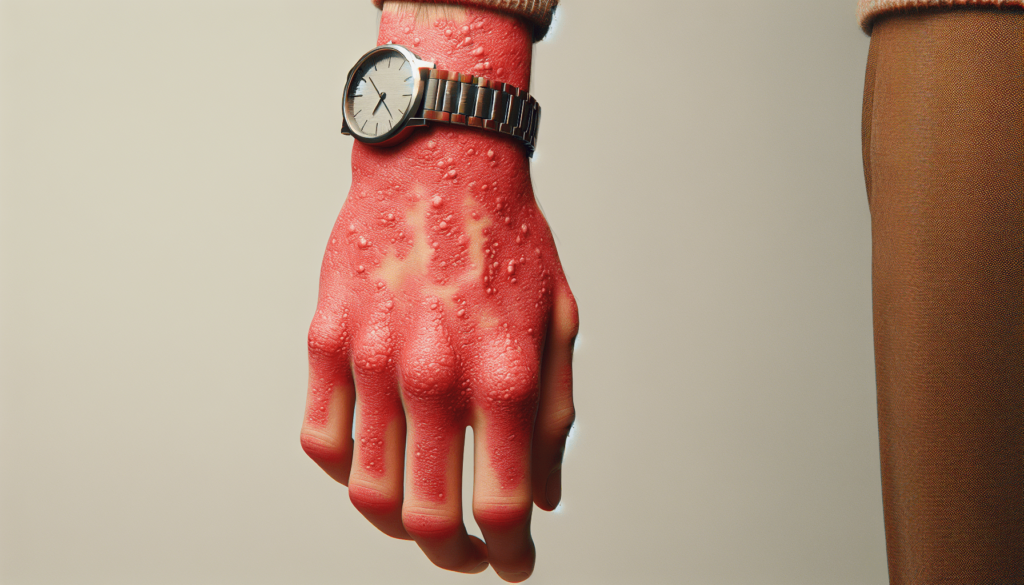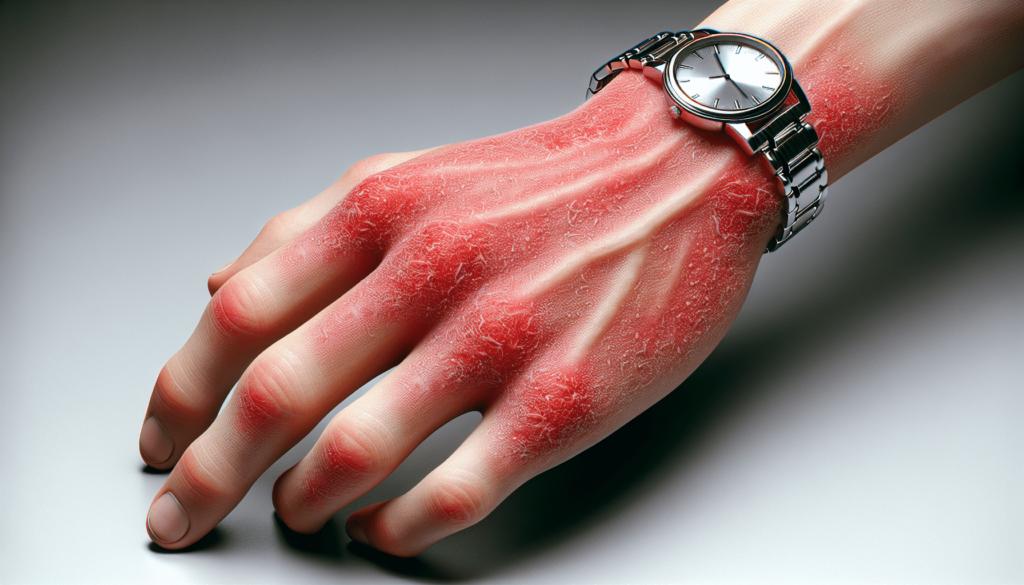Welcome to a journey of understanding “Identifying And Managing Nickel Allergies.” In this article, you’ll discover everything you need to know about recognizing and handling an allergy to nickel, a common yet often overlooked cause of irritation. You’ll learn how to spot the telltale signs of a nickel allergy—from itchy rashes to more severe skin reactions—and explore practical strategies to manage and prevent flare-ups. By the end, you’ll be equipped with valuable tips and insights to help you or your loved ones lead a more comfortable, nickel-free life. Have you ever experienced itchy skin or a rash after wearing jewelry or coming into contact with certain metal objects? If so, you might have a nickel allergy. Nickel allergies are quite common and can be particularly frustrating since nickel is found in many everyday items. But don’t worry; with a little knowledge, you can manage this allergy effectively.

What is a Nickel Allergy?
A nickel allergy is a type of contact dermatitis, which is an inflammatory skin condition triggered by contact with certain substances. Nickel is a common trigger, leading to an allergic reaction in some people. The reaction can vary from mild itching to severe rashes and discomfort.
How Do You Develop a Nickel Allergy?
Nickel allergies are usually developed through prolonged or repeated exposure to nickel-containing items. While anyone can develop a nickel allergy, some people are more susceptible due to genetic factors or even pre-existing skin conditions.
Common Sources of Nickel
Nickel can be found in a wide array of everyday items. Knowing where nickel is found can help you avoid exposure. Here are some common sources:
| Source | Examples |
|---|---|
| Jewelry | Earrings, necklaces, bracelets, rings |
| Clothing | Belt buckles, zippers, buttons, snaps |
| Electronics | Cell phones, laptops, remote controls |
| Personal Items | Eyeglass frames, coins, keys |
| Household Items | Kitchen utensils, door handles, scissors |
Symptoms of Nickel Allergy
Symptoms can manifest within hours or days after exposure to nickel. Being aware of them can help you identify and react promptly.
Immediate Symptoms
- Itching: One of the first symptoms is often an itch at the point of contact.
- Redness: The skin may appear red and inflamed.
Delayed Symptoms
- Rash: Small, reddish bumps can appear.
- Blisters: In severe cases, fluid-filled blisters may form.
- Dry, cracked skin: Over time, the skin may dry out and crack.
Chronic Symptoms
- Thickened Skin: Prolonged exposure can lead to thick, leathery skin.
- Darkened Skin: The affected area may become darker.
Diagnosis of Nickel Allergy
If you suspect you have a nickel allergy, it’s important to get a proper diagnosis.
Consult a Dermatologist
A dermatologist can perform tests, typically a patch test, to confirm if you have a nickel allergy. During a patch test, small amounts of various allergens, including nickel, are applied to your skin to see if any reaction occurs.
Self-Diagnosis
While not as accurate as a medical test, keeping a diary of your symptoms and their triggers can help in identifying a nickel allergy. Note when symptoms appear, what you were in contact with, and any changes in your environment.
Managing a Nickel Allergy
Once you’ve identified a nickel allergy, the next step is learning how to manage it. The good news is that with a few lifestyle changes, you can significantly reduce the impact on your daily life.
Avoiding Nickel Exposure
The most effective way to manage a nickel allergy is to avoid nickel-containing items.
| Category | Tips for Avoidance |
|---|---|
| Jewelry | Opt for hypoallergenic jewelry made from materials like stainless steel, titanium, or nickel-free alloys. |
| Clothing | Choose plastic or coated-metal accessories. Cover metal parts with clear nail polish as a temporary fix. |
| Electronics | Use cases or covers for devices to minimize direct contact. |
| Personal Items | Seek out nickel-free eyewear and avoid handling coins for prolonged periods. |
| Household Items | Use cookware and utensils made from nickel-free stainless steel or other materials. |
Nickel-Free Alternatives
Many items now come in nickel-free versions. From jewelry to household utensils, you can find alternatives that look and function just as well without triggering an allergic reaction.
Use Protective Barriers
Sometimes avoiding contact with nickel is unavoidable. When this happens, consider using protective barriers. Gloves, clear nail polish, and specific skin creams designed for metal allergens can block nickel contact.

Treatment for Nickel Allergy Reactions
Even with the best precautions, you may occasionally come into contact with nickel. When this happens, it’s essential to know how to treat the reaction promptly.
Over-the-Counter Treatments
- Antihistamines: These can help reduce itching and inflammation.
- Topical Steroids: Hydrocortisone cream is a common treatment for reducing inflammation and itching.
- Moisturizers: Use fragrance-free moisturizers to help soothe and repair the skin.
Prescription Treatments
Sometimes, over-the-counter treatments might not suffice, and you may need prescription medications.
- Stronger Topical Steroids: For more severe reactions, stronger topical steroids prescribed by a dermatologist.
- Oral Steroids: In extreme cases, oral steroids may be necessary to reduce severe inflammation.
- Immunosuppressive Medications: In chronic cases, medications to suppress the immune response might be considered.
Home Remedies
- Cold Compresses: Applying a cold compress can help soothe itching and reduce inflammation.
- Oatmeal Baths: An oatmeal bath can be soothing and help reduce itchiness.
- Aloe Vera Gel: Known for its soothing properties, aloe vera can be applied to calm irritated skin.
Practical Tips for Daily Life with a Nickel Allergy
Living with a nickel allergy means paying a bit more attention to your choices and surroundings. Here are some practical tips to help you navigate daily life more comfortably.
At Home
- Nickel-Free Utensils: Use kitchen utensils made from materials like wood, plastic, or nickel-free stainless steel.
- Furniture and Decor: Opt for furniture with minimal metal parts or ensure the metal used is nickel-free.
At Work
- Workspace Setup: Use protective covers for any metal equipment or tools you use frequently.
- Clothing and Accessories: Choose work attire with minimal or covered metal parts.
While Shopping
- Read Labels: Always check labels for nickel-free assurances when buying new products.
- Test Products: Some stores provide nickel test kits to check new items before purchase.
Nickel Allergy in Children
Nickel allergies are not just an adult issue; children can be affected too. Here’s how to manage a nickel allergy in kids.
Identifying Symptoms in Children
Children may not always communicate their discomfort clearly. Look out for itching, redness, or rashes, especially around areas of contact with metal objects like jewelry or clothing fasteners.
Managing Exposure
- Clothing: Check children’s clothing for nickel-containing parts like zippers and snaps and cover them with fabric.
- Toys and Accessories: Ensure toys are made of nickel-free materials. Opt for plastic or wooden toys.
Educating Children
Help kids understand their allergy in simple terms. Teach them to avoid certain items and explain why it’s essential for their well-being.
Traveling with a Nickel Allergy
Traveling can be stressful, more so if you have a nickel allergy. However, with some preparation, you can enjoy your trip comfortably.
Pre-Travel Preparations
- Plan Ahead: Research your destination for any unique challenges. Consider carrying your nickel-free items to avoid surprises.
- Medical Kit: Pack a small kit with your prescribed medications, over-the-counter treatments, and protective barriers.
On the Go
- Public Transportation: Be cautious about metal parts in public transport. Use protective covers where needed.
- Hotels: Sometimes hotel fixtures might contain nickel. Consider carrying your covers to protect against contact.
Advancements and Research in Nickel Allergy Management
Research is ongoing to improve the lives of those dealing with nickel allergies. From new treatments to better diagnostic methods, science is continually advancing.
New Diagnostic Methods
Researchers are working on better, more accurate diagnostic methods to identify nickel allergies quicker and more precisely. These advancements aim to reduce the delay in diagnosis and provide earlier intervention.
Innovative Treatments
New treatments, including topical creams with advanced formulations and immunotherapy approaches, are being developed. These treatments aim to provide more effective relief with fewer side effects.
Nickel-Free Products
The market for nickel-free products is expanding. Many brands now offer a wide array of nickel-free items, from jewelry to everyday appliances, making it easier for you to live comfortably without exposure.
Psychological Impact of Nickel Allergy
Living with a nickel allergy can also have psychological effects. Constant vigilance and dealing with reactions can cause stress and anxiety.
Coping Strategies
- Support Groups: Joining a support group can provide emotional support and practical tips.
- Mindfulness and Stress Management: Practices like mindfulness, yoga, or other stress-relief techniques can help manage the psychological impact.
- Education: The more you know about your allergy, the better you can manage it, reducing anxiety and building confidence.
Speaking to a Professional
If you find that your nickel allergy is causing significant stress or affecting your mental health, it might be helpful to speak with a healthcare professional. Therapists can provide strategies and tools to manage anxiety and stress related to chronic conditions.
Myths and Facts About Nickel Allergy
There’s a lot of misinformation about nickel allergies. Let’s clear up some common myths and present the facts.
| Myth | Fact |
|---|---|
| Nickel Allergy is Rare | Nickel allergy is quite common, affecting many people worldwide. |
| All Metal Objects Contain Nickel | Not all metals contain nickel; many alternative materials are available. |
| Reactions Only Happen Immediately | Reactions can be delayed, appearing hours or even days after exposure. |
| Nickel Allergy Can Be Outgrown | Nickel allergy is usually lifelong. However, reactions can be managed with proper care. |
| Nickel Allergy Only Affects the Skin | While primarily a skin condition, severe cases can have broader health implications. |
Conclusion
Dealing with a nickel allergy can be challenging, but with the right knowledge and strategies, you can manage it effectively. By understanding what triggers your allergy, making informed choices, and following appropriate treatments, you can reduce your symptoms significantly.
Remember, you’re not alone—many people manage nickel allergies successfully, and with a bit of effort, you can too. Always consult with your healthcare provider for personalized advice, and make sure to educate those around you about your condition for a more supportive environment.
Take control of your nickel allergy today, and reclaim your comfort and peace of mind!
